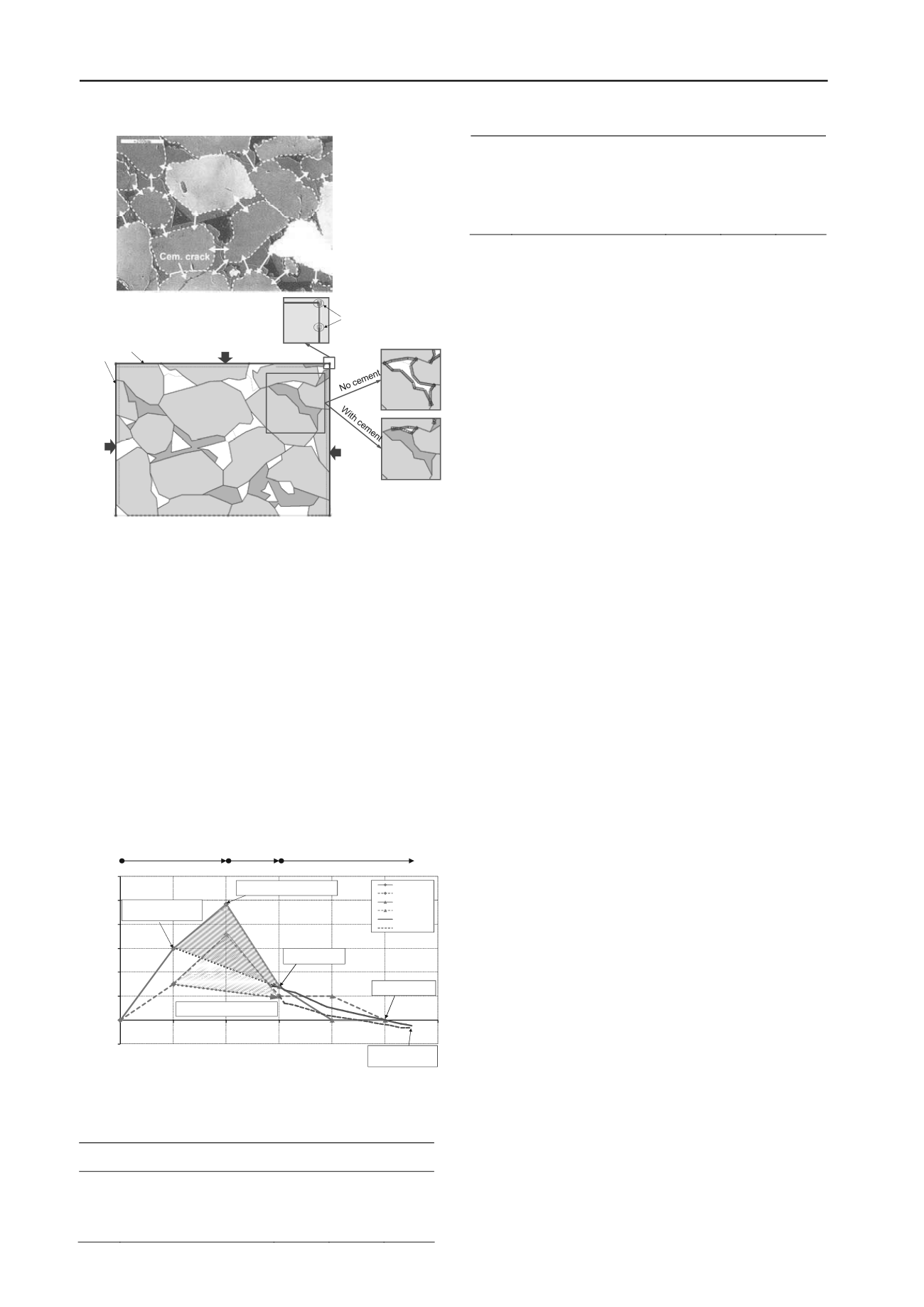
1021
Technical Committee 105 /
Comité technique 105
Vertical stress,
V
Horizonatl stress,
h
Horizonatl stress,
h
Pore pressure,
u
Rotation
fixities
Beam
elements
Figure 3. Cathodoluminescence SEM picture (top) from Storvoll (2004)
and equivalent 2D micro FE-model (bottom) used for studying
formation damage around wellbore during drilling and coring
operations.
Then in the second stage the stress changes obtained from
the macro FE-model are applied at the boundary of a micro FE-
model in order to investigate tensile fracturing on the micro
level. Figure 3 shows the FE-model established based on a high
resolution cathololuminescence SEM picture of well cemented
sandstone (from Storvoll, 2004), where authigenic quartz
cement can clearly be separated from the original grains. For the
deeply buried Field A which has undergone both mechanical
and chemical compaction the cemented areas were activated at a
stress condition corresponding to a burial depth of about 4.1 km
corresponding to depth for onset of quarts cementation at
temperatures of 70 - 80
0
C (Bjørlykke, 1989). Field B has
undergone purely mechanical compaction due to the shallow
burial depth (< 2.4 km), and no cement was applied for this
model.
-10
0
10
20
30
40
50
60
0
1
2
3
4
5
6
Effective stresses (MPa)
Loading step
Sig'_v
Sig'_h
Sig'_vCoring
Sig'_hCoring
Sig'_vDrilling
Sig'_tDrilling
Approximatestressat2500 m
beforequarts cementation
Assuming hydrostaticpressure
Maxpossiblestressat 4100 m TWD
Assuming hydrostaticporepressure
Final effectivestress
aftercoring and retrieval
Measured in-situ stress
at4100 m TVD
Uncertain stresspath
Porepressure history is not known
Final effectivestress in
formationafterdrilling and
temperature reduction
Coring and
drilling
Mechanical and
chemical compaction
Mechanical
compaction
Figure 4. Idealized stress paths for Field A. Stress changes during
drilling and coring process are based on “macro” stresses released at
material point A plotted in Figure 5.
Table 2. Simplified burial history applied in micro FE-model.
Step Description
V
(MPa)
h
(MPa)
u
(MPa)
1
At 2500 m, no cement
55
40
25
2
At 4100 m, with cement
90
77
41
3
At 4100 m, in-situ state
90
85.8
75.8
4
Mud pressure & mud-flow
88.4
82.8
82.2
5
Temperature reduction (
0
C)
-
2.4
87.9
82.4
82.2
-
9.5
86.4
81.4
82.2
-
19.1
84.4
80.0
82.2
-
33.3
82.2
81.4
82.2
-
57.1
76.3
74.4
82.2
-
66.7
74.4
72.7
82.2
-
71.4
73.5
72.6
82.2
V
,
h
are total vertical and horizontal stresses, respectively
u is pore pressure
Figure 4 shows an idealized loading path being applied to the
micro FE-model at Field A. The stress changes during drilling
and coring processes are based on the “macro” stresses released
at the material Point A located at a distance of one radius into
the formation from the wellbore wall and two radius up from
the wellbore tip (see Figure 5). In the process of coring there is
first a total vertical stress unloading. This corresponds to
removing the weight of overburden during coring. Finally, the
horizontal stress is completely unloaded. This corresponds to a
situation after coring and core retrieval when pushing out the
core from the core cylinder. In the formation adjacent to the
wellbore the stress change is a combination of effect of pore
pressure changes, temperature effects and stresses from the
process of drilling. This is a complex process that requires FE
modelling. Therefore the final load step has been directly taken
from the calculated results of the macro FE-model. The
effective vertical and effective radial stresses at Point A after
drilling are shown in Figure 4. This includes unloading due to
mudflow into the formation and cooling of the formation. Note
that the final effective stresses shown in the figure corresponds
to a cooling of about 70
0
C, which is a higher temperature
reduction than experienced in the field. Also, the tangential
stress which is most critical with respect to micro fractures is
not shown in this figure. Table 2 summarizes the burial history
at Field A which is applied at the boundary of a micro FE-
model in order to investigate tensile fracturing on the micro
level.
3 RESULTS FROM MACRO FE-MODEL
From the results of the 3D modelling in it is found that at a
distance of one radius from the wellbore wall the application of
the drill bit forces gives minor effect in terms of stress changes
compared to the effects from mud pressure, mud-fluid flowing
into the formation and temperature reduction. In fact, damage
only occurs very locally at the edges of the gauge pads and
drilling cutters. Since the effects from the drill bit can be
neglected, for a matter of modelling simplification and also to
minimize the time necessary for processing, a macro
axisymmetric FE-model has been established and used for
studying the other effects with respect to the wellbore damage.
Figure 5 shows that the macro (continuum) analysis predicts
tensile fracturing within one radius into the formation (point A)
after circa 67
0
C of cooling. This value is not in agreement with
field observations which indicate fracturing at much lower
temperature differences as observed from the Radial Dipole
Profiling data. Hence a further evaluation of tensile fracturing
on a micro level was performed with a 2D micro FE-model
(grain scale).
4 RESULTS FROM MICRO FE-MODEL
In both the Field A and the Field B case, it is found that onset
and development of tensile fractures starts at a lower
temperature reduction in the micro FE-model (Figure 6) then in
the macro FE-model (see Figure 5). The micro FE-model thus
seems to pick up formation damage that cannot be found when
applying a macro FE-model, and this model is closer to explain
the observed potential stiffness reduction based on the
difference between the mud temperature and the formation
temperature of 25-35
0
C as indicated from downhole
temperature log. There are however limitations in the 2D micro
model and the results should only be used as a indications of


